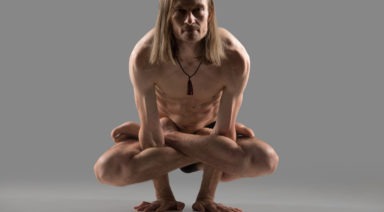Viparita Karani: Legs Up The Wall Pose

Viparita karani (vip-par-ee-tah car-AHN-ee) is a gentle restorative pose. This slightly inverted pose can ease busy mind chatter and may relieve uncomfortable symptoms like tension and menstrual cramps. You may enjoy practicing this pose with a block, folded blanket, or pillow under your hips to lift your hips above the plane of your heart.
Sanskrit:
- Viparita: reversed/inverted
- Karani: doing/action
Physical Benefits:
- Relieves tired feet and legs.
- Gently stretches the hamstrings and legs.
- Can relieve discomfort in the lower back.
Energetic Benefits
- Thought to calm the mind.
- Thought to ease symptoms of anxiety and stress.
Preparatory Poses:
- Bridge pose | Setu bandha sarvangasana
- Child pose | Balasana
- Standing forward fold | Uttanasana
Sequential Poses:
- Shoulder stand on the wall
- Dragonfly on the wall
- Figure four on the wall
Counter Poses:
- Savasana
Adjustments/Modifications:
- Place a pillow, bolster, or folded blanket under your hips to release the hamstrings and low back.
- Gently lower your feet out to the sides so your legs make a wide “V” shape for dragonfly on the wall.
- Place a rolled up blanket under your neck for additional support.
- Loop a strap around your thighs to allow the legs to relax more deeply.
Step-By-Step:
- Begin seated beside an open wall, with your hip and shoulder against the wall.
- Gently lower your torso down to the ground as your legs lift up against the wall.
- Option to wiggle closer to or further away from the wall to your comfort level.
- Option to place a block, pillow, or folded blanket under your hips to release any discomfort in the low back or hamstrings.
- Allow your head to rest on the ground or a pillow and place your arms wherever they are most comfortable.
- Stay anywhere from one to 15 minutes.
- To release, push the bottoms of your feet into the wall and lift your hips slightly. If using a support, move the support out of the way. Gently roll to one side and stay for a few breaths before returning to your seat.
###Legal Disclaimer Before participating in any exercise program or using any fitness products or services that may be described and/or made accessible in or through the Gaia Website and/or the Services, you should consult with a physician or other healthcare provider. Read more about Gaia’s Terms of Use.
Hand to Toe | Yoga Pose

ADJUSTMENTS | BENEFITS | CONTRAINDICATIONS | MANTRA | MUDRA | PREP POSES | SANSKRIT | STEPS | TIPS
Utthita hasta padangusthasana (oo-TEET-uh-HAWS-tuh POD-ung-goos-THAWS-un-nuh), also known as extended hand or hand-to-toe pose, is a challenging and invigorating posture that stretches and strengthens while calming the mind and improving focus. During each exercise, make sure to maintain a focus on your breathing as it hones your attention, focusing your mind on the constant change as you breathe in and out.




































